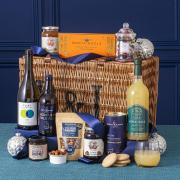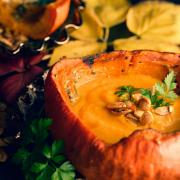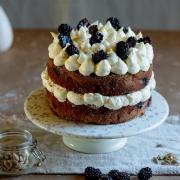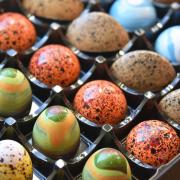I have to confess, I am that diner, who, when presented with a menu, will always look to the dessert page to discover what’s in store.
This will guide all of my other menu choices and leads to no little impatience as I race through my starter and main course in order to reach the most important part of the meal.
If there’s a tarte tatin on the carte, then I become that jittery diner, unable to concentrate on conversations, the luxurious surroundings or the occasion, all of my focus reserved for the puddings.
Even as a boy, my brothers and I would always ask ‘what’s for afters?’ as we sat at the table waiting for our ‘befores’.
I am the sort of person who deliberately seeks out spoilers for TV soaps, reads the last chapter of a book to see what happens (which determines if it’s worth reading) or attempts to make a dish from a recipe book by looking at the picture rather than reading a recipe.
In other words, I always have an eye on the finale.
The last of my examples - making dishes without consulting recipes - is not to be recommended if you’re going to recreate these summer treats.
There’s a very good reason why so many cooks have a fear of pastry: everything has to be meticulously weighed and every step taken in the right order.
Any form of baking has a close affinity with chemistry and alchemy which is why pastry chefs (rightly) believe they are a class apart from us good old ‘hot kitchen’ chefs.
(The ‘hot’ in questions refers to our section in the kitchen rather than our gorgeousness, or so pastry chefs tell us)
It’s well documented here in the pages of previous Norfolk magazines how much I love a good old-fashioned winter pudding, but let’s not be wistful. June opens up a veritable treasure chest of fruit and vegetables, offering fresh vibrant flavours that can be transformed into the most glorious desserts.
Here’s a selection of my favourites, but I’m just as happy with the first of the English berries and a scoop of ice cream - you definitely don’t need a recipe for that.

Passion Fruit Tart recipe
Ingredients:
For the pastry:
225g plain flour, plus extra to dust
2 tablespoons icing sugar
1/4 teaspoon salt
165g cold butter
Cold water
The filling:
8 passion fruit
4 large eggs
Juice of one large orange or 50ml of orange juice
150ml double cream
75g caster sugar
Icing sugar to dust
Preheat the oven to 200C/180C fan/Gas 6
Method:
To make the pastry:
Mix the flour, sugar and salt in a bowl and then grate in the cold butter. Rub into the flour, then stir in just as much cold water (about two tablespoons should do it) as you need to bring it together into a dough.
Grease a 25cm tart tin and roll out the pastry on a lightly-floured surface until large enough to line the tin. After you have lined your tin with pastry, chill in the refrigerator for another 30 minutes.
Line the pastry case with non-stick baking paper and fill with baking beans. Blind bake in the oven for about 15 minutes, or until lightly golden at the edges. Remove the paper and beans and return to the oven for a further five minutes until the pastry is crisp and lightly golden.
Reduce the oven temperature to 160C/140 fan/Gas 3
Make the filling:
Slice the passion fruit in half and remove the pulp. Sieve the pulp into a large bowl, discarding the seeds. Break the eggs into the bowl, then add the orange juice, double cream and sugar and beat well until combined.
Transfer the passion fruit custard into a jug, then pour into the pastry case and carefully slide back into the oven. Bake for 35-40 minutes until the custard is set in the middle with a very slight wobble.
Leave to cool, then place in the fridge to chill. Dust with icing sugar and serve at room temperature with cream, ice cream or fruit sorbet on the side.

Baked Vanilla Cheesecake recipe
Ingredients:
650g cream cheese
175g Digestive biscuits
75g salted butter, melted
175g golden caster sugar
100ml double cream
3 large eggs
1 teaspoon vanilla extract
1 orange, zest
For the compote:
300g pitted cherries or blueberries, frozen
3 tablespoons caster sugar
Preheat the oven to 150C/Fan 140C/Gas Mark 2
Method:
Crush the biscuits into fine crumbs either by whizzing in a food processor or by putting them in a food bag and smashing them with a rolling pin (great for stress relieving…).
Transfer to a bowl and stir in the melted butter. Spoon this mixture into the base of a 20cm (8 inch) springform tin, pressing the biscuit well into the base.
Spoon the soft cheese into a large bowl and beat well to soften. Add the golden caster sugar, double cream, eggs, vanilla extract and orange zest.
Mix well until all the ingredients are evenly combined. Pour this mixture over the top of the biscuit base.
Bake in the oven for 30 minutes then turn off the heat and allow to finish cooking in the heat of the oven (the cheesecake will still be quite wobbly at this stage).
Carefully remove from the oven and chill overnight or at least four hours.
To make the compote, tip the frozen berries straight into a saucepan and sprinkle over the caster sugar.
Stir well over a gentle heat until the fruit has softened and the juices are beginning to bubble. Allow to cool, taste as you may need to add more sugar.
To serve, cut the cheesecake into wedges and drizzle over a little of the compote. You can add whipped double cream if you wish to gild the lily.

Strawberry, Pimms and Elderflower Trifle recipe
(makes a two pint serving dish or four individual trifles)
Ingredients:
8 trifle sponges or one small Madeira sponge cake
250g strawberries
1 tablespoon of caster sugar
85g strawberry jelly
4 tablespoons of Pimms
2 tablespoons of elderflower cordial
750ml cold, thick custard (we use Bird’s Custard!)
300ml double cream
100g natural yoghurt
1 teaspoon lemon zest
Method:
Break the trifle sponges or Madeira cake into pieces and arrange in a single layer in the base of a 1.2 litre/two pint glass bowl or, if you prefer, into individual trifle glasses.
Moisten the sponge with Pimms.
Prepare the strawberry jelly as per the packet instructions and allow to cool.
When the jelly reaches setting point, fold in the chopped strawberries (save a few for decoration) and spoon on to the sponge.
Spoon the custard over the top of the fruit and spread the top until you have an even layer.
Whip the cream, the tablespoon of sugar and the elderflower cordial in a bowl until it just forms soft peaks, then add in the yoghurt and lemon zest.
Spoon the cream over the top of the custard and chill until required.
Decorate with halved strawberries. We always show off just a little by adding a few extras - edible flowers, crushed nut brittle, honeycomb or even gold leaf. But strawberries are definitely enough!



























